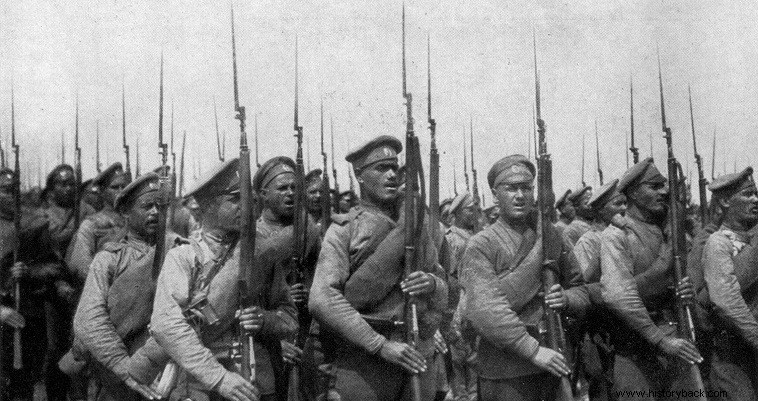
The Russian Army in 1914 was facing equally important problems. Its main advantage was its inexhaustible reserves of human resources. But beyond that, the humiliating defeat in 1904-05 by the Japanese had left a deep mark on the morale and doctrine of the army.
In general, the Russian Army could not be described as only fighting. One of the main causes of this event was the deep division that prevailed in the officer corps, from the Ministry of War, down to the company level! In addition to all the problems, the main cause was the assumption of leadership of his general staff, initially and of the Ministry of War, a little later, by general Vladimir Alexandrovich Sukomlinov.
A cavalry officer obsessed with offensive tactics, he refused to accept that the nature of warfare had changed since the Napoleonic period. He himself, owing his rise not to his merit, boasted that he had 25 years, after graduating as an officer, to read even a military manual! The Russian Army was left in the hands of him and his followers, with whom he made sure to fill all the key positions.
In many cases, Sukhomlinov covered for officers in his entourage and even known German spies, or speculators who were essentially stealing from the army's coffers.
In such a climate of corruption only a fool could believe that the Russian Army could perform. Unfortunately, this fool existed and was Tsar Nikaos II himself.
"At 62 himself, a slave to his beautiful, only 32-year-old wife, intelligent but rude, servile to the Tsar, a friend of Rasputin, surrounded by a mob of middlemen for his intrigues, he is a man who has forgotten what it is like to you work and exhausts his energy in shocking anecdotes", the French ambassador to Russia wrote about the Russian general Shukomlinov.
The Russian chief of staff, responsible for the planning of military operations, Lt. General Danilov, was at the same level of quality. Danilov, imbued with the doctrine of "encircled" Russia, went so far as to make plans for the country's war with Sweden, Romania, Austria, Germany, China and Japan, combined! As one officer commented, "only the Martians were not included in his plans".
As far as Russian army concentration plans were concerned, Danilov was an advocate of strategic defense on the line of Pripet marshes , with the main strategic concentration north of them (59 MP) and the smallest south against the Austrians (19 MP). His plan, however, provided for the abandonment of Poland without a fight and consequently was not approved, although he himself did not lose his position.
On the contrary the Russian Army adopted another strategic concentration plan which provided for the deployment of two armies, 1st and 2nd against the German forces of South Prussia (Northwest Front). South of them were deployed the forces of the Southwestern Front under General Ivanov.
His forces consisted, from North to South, of the 4th Army, under the German-born General Anton von Zalza (5 Army Corps (SS), eight active and later three reserve Infantry Divisions (MP), four Cavalry Divisions -MI), the 5th Army, under General Pavel von Plewe, also of German origin (six SS, eight active MP, and later five reserve MP, five MI).
Next came the 3rd Army, under General Nikolai Rutsky, the strongest of all (10 SS, 16 active MP, and later five reserve MP, nine MI). This army was eventually divided and half of its forces were formed into the 8th Army, commanded by General Alexei Brusilov.
The active Russian forces stationed in Poland were allocated mainly to the armies destined to invade An. Prussia. Thus, the armies destined for the fight in Galicia would also have a significant number of conscripted divisions whose personnel, given the performance of the Russian railways, would take quite a while to join the MP houses.
The Russian MP of the time was organized like the corresponding Austrian one. Line up two brigades, each with two regiments, each with four battalions. It also had an artillery brigade (six artillery brigades, each of eight guns, 48 guns), but also one or two small cavalry brigades (usually 8-12 iles). The brigades, however, withdrew from the infantry formations and formed independent cavalry formations.
A major drawback of the Russian Army was its poor accounting service and the small kept stock of ammunition, especially in the artillery. The Russian Army was the only one to enter World War I with a stock of less than 1,000 rounds per gun.
This stockpile was even smaller, in fact, as, apart from front-line ammunition, the rest was kept in warehouses in the interior and took a long time to transport to the front.
